Which of the following statements is false?
a. pili enable bacteria to attach to another bacteriun or to the
surface membranes of their hosts
b. some plasmids confer
resistance to various antibiotics
c. plasmids can act in a way
that allows a bacterium to donate DNA during conjugation
d. in
bacterial photosynthesis, oxygen is not a by-product
e. plasmids
permit bacteria to carry on autotrophic reactions such as chemosynthesis
E
Nitrogenase, the enzyme that catalyzes nitrogen fixation, is
inhibited whenever free O2 reaches a critical concentration.
Consequently, nitrogen fixation cannot occur in cells wherein
photosynthesis produces free O2. Consider the colonial aquatic
cyanobacterium Anabaena, whose heterocytes are described as having
"a thickened cell wall that restricts entry of O2 produced by
neighboring cells. Intracellular connections allow heterocysts to
transport fixed nitrogen to neighboring cells in exchange for
carbohydrates."
Which two of the following question
arise from a careful reading of this quotation, and are most important
for understanding how N2 enters heterocysts, and how O2 is kept out of
heterocysts?
1. If carbohydrates can enter the heterocysts from
neighboring cells via the "intracellular connections," how
is it that O2 doesn't also enter via this route?
2. If the cell
walls of Anabaena's photosynthetic cells are permeable to O2 and CO2,
are they also permeable to N2?
3. If the nuclei of the
photosynthetic cells contain the genes that code for nitrogen
fixation, how can these cells fail to perform nitrogen
fixation?
4. If the nuclei of the heterocysts contain the genes
that code for photosynthesis, how can these cells fail to perform
photosynthesis?
5. If the cell walls of Anabaena's heterocysts
are permeable to N2, how is it that N2 doesn't diffuse out of the
heterocysts before it can be fixed?
6. If the thick cell walls of
the heterocysts exclude entry of oxygen gas, how is it that they don't
also exclude the entry of nitrogen gas?
a. 3 and 4
b. 1 and 3
c. 2 and 5
d. 4 and 6
e. 1 and 6
E
The earliest organisms were probably unicellular
a. heterotrophs
b. aerobes
c. eukaryotes
d. autotrophs
A
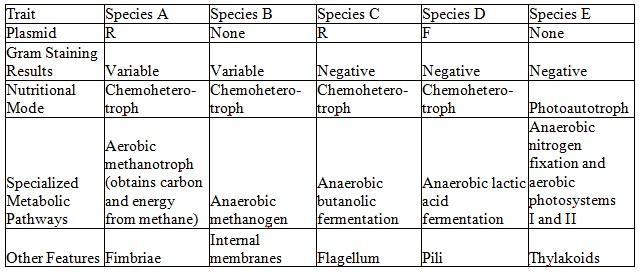
which species should be able to respond most readily to taxes (plural of taxis)?
a. species D
b. species A
c. species C
d. species B
e. species E
C
Broad-spectrum antibiotics inhibit the growth of most intestinal bacteria. Consequently, assuming that nothing is done to counter the reduction of intestinal bacteria, a hospital patient who is receiving broad-spectrum antibiotics is most likely to become
a. unable to fix nitrogen
b. antibiotic resistant
c. deficient in certain vitamins and nutrients
d. unable to synthesize peptidoglycan
e. unable to fix carbon dioxide
C
In many aspects, bacteria are more "advanced" in their ___ than in their ___.
a. matabolism; genetic composition
b. behavior; structure
c. chemical composition; classification
d. reproduction; structure
B
If all prokaryotes on earth suddenly vanished, which of the following would be the most likely and most direct result?
A) The number of organisms on Earth would decrease by 10-20%.
B) Human populations would thrive in the absence of disease.
C) Bacteriophage numbers would dramatically increase.
D) The recycling of nutrients would be greatly reduced, at least initially.
E) There would be no more pathogens on Earth.
D
Match the numbered terms to the description that follows. Choose all appropriate terms.
- autotroph
- heterotroph
- phototroph
- chemotroph
an organism that obtains both carbon and energy by ingesting prey
- A) 1 only
- B) 4 only
- C) 1 and 3
- D) 2 and 4
- E) 1, 3, and 4
D
Approximately how far back in time does the fossil record extend?
- A) 3.5 million years
- B) 5.0 million years
- C) 3.5 billion years
- D) 5.0 billion years
C
In 2009, which of the following did scientists discover was possible on early Earth?
- A) abiotic synthesis of RNA monomers
- B) bacterial cell walls made mainly of chitin
- C) gram-positive bacteria with outer membranes that contain lipopolysaccharides
- D) gram-negative bacteria with cell walls composed of a thick layer of peptidoglycan
A
In general, what is the primary ecological role of prokaryotes?
- A) parasitizing eukaryotes, thus causing diseases
- B) breaking down organic matter
- C) metabolizing materials in extreme environments
- D) adding methane to the atmosphere
- E) serving as primary producers in terrestrial environments
B
Which of the following steps has not yet been accomplished by scientists studying the origin of life?
- A) synthesis of small RNA polymers by ribozymes
- B) abiotic synthesis of polypeptides
- C) formation of molecular aggregates with selectively permeable membranes
- D) formation of protocells that use DNA to direct the polymerization of amino acids
D
Which of these statements about prokaryotes is correct?
- A) Bacterial cells conjugate to mutually exchange genetic material.
- B) Their genetic material is confined within vesicles known as plasmids.
- C) They divide by binary fission, without mitosis or meiosis.
- D) The persistence of bacteria throughout evolutionary time is due to their lack of genetic variation.
- E) Genetic variation in bacteria is not known to occur because of their asexual mode of reproduction.
C
Which of the following traits do archaeans and bacteria share?
- composition of the cell wall
- presence of plasma membrane
- lack of a nuclear envelope
- identical rRNA sequences
a. 3 only
b. 2 and 4
c. 2 and 3
d. 1 only
e. 1 and 3
C
Although not present in all bacteria, this cell covering often enables cells that possess it to resist the defenses of host organisms, especially their phagocytic cells.
- A) endospore
- B) sex pilus
- C) cell wall
- D) capsule
D
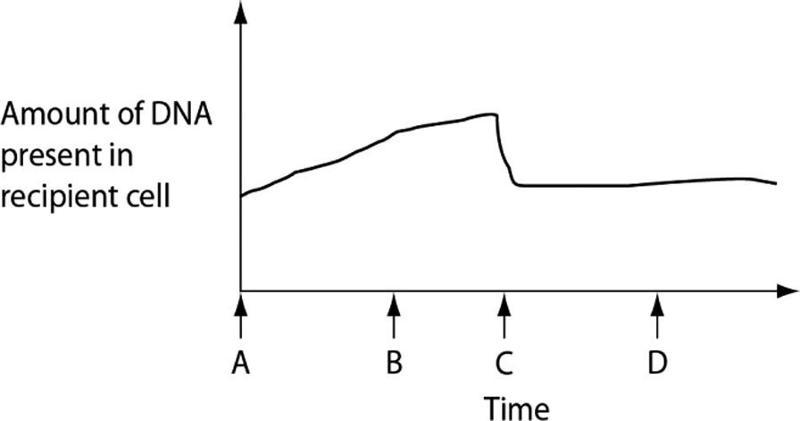
Which question arising from the results depicted in Figure 24.2 is most interesting from a genetic perspective and has the greatest potential to increase our knowledge base?
- A) If reciprocal crossing over could occur even if the piece of donated Hfr DNA is identical to the homologous portion of the recipient's chromosome, what prevents this from occurring?
- B) What forces are generally responsible for disrupting the sex pilus?
- C) How is it that a recipient cell does not necessarily become an Hfr cell as the result of conjugation with an Hfr cell?
- D) What makes a cell an Hfr cell?
A
Nitrogenase, the enzyme that catalyzes nitrogen fixation, is
inhibited whenever free O₂ reaches a critical concentration.
Consequently, nitrogen fixation cannot occur in cells wherein
photosynthesis produces free O₂. Consider the colonial aquatic
cyanobacterium, Anabaena, whose heterocytes are described as having
"…a thickened cell wall that restricts entry of O₂ produced by
neighboring cells. Intracellular connections allow heterocysts to
transport fixed nitrogen to neighboring cells in exchange for
carbohydrates."
61) Given that the enzymes that
catalyze nitrogen fixation are inhibited by oxygen, what are two
"strategies" that nitrogen-fixing prokaryotes might use to
protect these enzymes from oxygen?
1. couple them with
photosystem II (the photosystem that splits water molecules)
2.
package them in membranes that are impermeable to all gases
3. be
obligate anaerobes
4. be strict aerobes
5. package these
enzymes in specialized cells or compartments that inhibit oxygen
entry
A) 1 and 4
B) 2 and 4
C) 2 and 5
D) 3
and 4
E) 3 and 5
E
Suppose it were possible to conduct sophisticated microscopic and chemical analyses of microfossils found in 3.5-billion-year-old stromatolites. Which of the following structures would be surprising to observe?
- RNA
- vesicles
- a nucleus
- ribozymes
a. I
b. II
c. III
d. IV
C
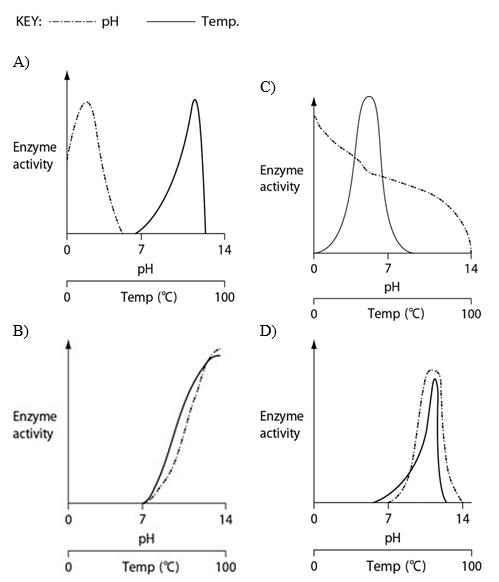
Thermoacidophiles are archaeans that are able to successfully live and reproduce in environments that are acidic, have high sulfur content and temperatures, and have little organic material. Consider the thermoacidophile Sulfolobus acidocaldarius. Which of the following graphs most accurately depicts the expected temperature and pH profiles of its enzymes? (Note: The horizontal axes of these graphs are double, with pH above and temperature below.)
a. a
b. b
c. c
d. d
A
when free oxygen became available in the atmosphere,
a. some cells and forms of life became extinct.
b. oxygen was used as a dumping place for hydrogen ions and electrons
c. some organisms changed their metabolism.
d. aerobic respiration emerged.
e. all of these.
E
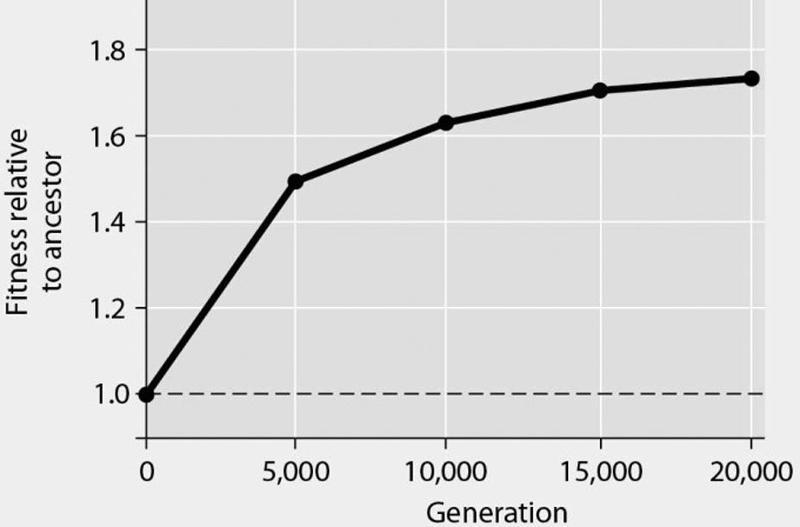
In Figure 24.1, data are presented from an eight-year experiment in which 12 populations of Escherichia coli, each begun from a single cell, were grown in low-glucose conditions for 20,000 generations. Each culture was introduced to fresh growth medium every 24 hours. Occasionally, samples were removed from the populations, and their fitness in low-glucose conditions was tested against that of members sampled from the ancestral (common ancestor) E. coli population.
If new genetic variation in the experimental populations arose solely by spontaneous mutations, then the most effective process for subsequently increasing the number of individuals that possess all of these beneficial mutations is
- A) transduction.
- B) binary fission.
- C) conjugation.
- D) transformation.
- E) meiosis.
B
which statement about the genomes of prokaryotes is correct?
- A) Prokaryotic genomes are diploid throughout most of the cell cycle.
- B) Prokaryotic chromosomes are sometimes called plasmids.
- C) Prokaryotic cells have more proteins than eukaryotes.
- D) The prokaryotic chromosome is not contained within a nucleus but, rather, is found at the nucleolus.
- E) Prokaryotic genomes are composed of circular DNA.
E
Match the numbered terms to the description that follows. Choose all appropriate terms.
- autotroph
- heterotroph
- phototroph
- chemotroph
a prokaryote that obtains both energy and carbon as it decomposes dead organisms
- A) 1 only
- B) 4 only
- C) 1 and 3
- D) 2 and 4
- E) 1, 3, and 4
D
Prokaryotes' essential genetic information is located in the
- A) flagella.
- B) nucleoid.
- C) capsule.
- D) plasmids.
- E) endospore.
B
Which of the following can bacteria use as an energy source?
a. hydrogen sulfide
b. nitrites
c. sunlight
d. ammonia
e. all of these
E
Fossilized stromatolites
- A) more than 2.8 billion years old have not been discovered.
- B) formed around deep-sea vents.
- C) resemble structures formed by bacterial communities that are found today in some shallow marine bays.
- D) provide evidence that photosynthesis was occurring in the oceans by 2.5 billion years ago.
C
Which of the following is an important source of endotoxin in gram-negative species?
- A) endospore
- B) sex pilus
- C) flagellum
- D) cell wall
- E) capsule
D
What is a main difference between endotoxins and exotoxins?
- A) Endotoxins are proteins and exotoxins are lipopolysaccharides.
- B) Endotoxins are lipopolysaccharides and exotoxins are proteins.
- C) Exotoxins are released only when the bacteria die and their cell walls break down.
- D) Exotoxins are made of RNA and endotoxins are made of DNA.
B
It is doubtful that many of the organic compounds essential for life, such as amino acids and nucelotides, would be able to assemble spontaneously in the presence of
a. carbon dioxide
b. free hydrogen
c. argon
d. hydrogen
e. nitrogen
B
The type of bacterium most likely to be found in a swamp is
a. thermophilic
b. cyanobacteria
c. methanogens
d. e. coli
e. halophilic
C
Experiments like those first performed by Stanley Miller in 1953 demonstrated that
a. DNA forms readily and reproduces itself
b. many of the lipids, carbohydrates, proteins, and nucleotides required for life can form under abiotic conditions
c. complete, functioning prokaryotic cells are formed after approximately three months
d. a lipid-protein film will eventually be formed by thermal convection.
e. all of these
B
Plantlike photosynthesis that releases O2 occurs in
- A) cyanobacteria.
- B) chlamydias.
- C) archaea.
- D) chemoautotrophic bacteria.
A
Bacteria can obtain their nutrition by
a. photosynthesis
b. chemosynthesis
c. heterotrophy
d. both (a) and (b)
e. all of these
E
Photoautotrophs use
A) light as an energy source and CO₂ as a
carbon source.
B) light as an energy source and methane as a
carbon source.
C) N₂ as an energy source and CO₂ as a carbon
source.
D) CO₂ as both an energy source and a carbon
source.
E) H₂S as an energy source and CO₂ as a carbon source.
A
Bacteria participate in many ecological interactions. which role typically does not involve symbiosis?
a. decomposing dead organisms and organic wastes
b. digesting food as mutualists in animal intestines
c. living as commensalists on the skin of humans
d. providing bioluminescence in fish.
A
Which of the following oxidizes inorganic substances to obtain energy
that is used, in part, to fix CO₂?
A) photoautotrophs
B)
photoheterotrophs
C) chemoautotrophs
D) chemoheterotrophs
that perform decomposition
E) parasitic chemoheterotrophs
C
The first genes on Earth were probably
- A) DNA produced by reverse transcriptase from abiotically produced RNA.
- B) DNA molecules whose information was transcribed to RNA and later translated in polypeptides.
- C) self-replicating RNA molecules.
- D) antibiotic resistant.
C
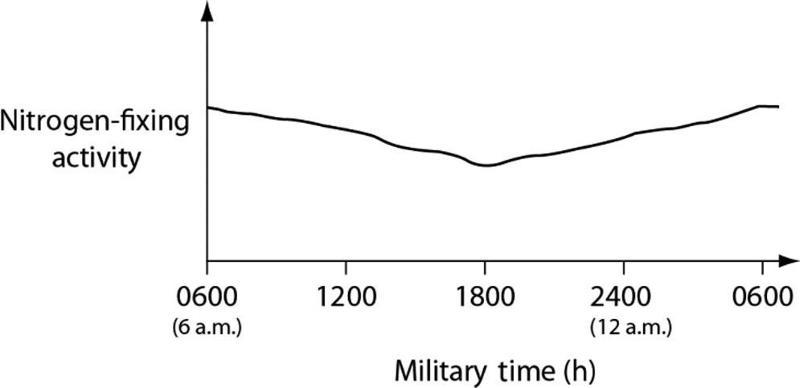
Data were collected from the heterocysts of a nitrogen-fixing cyanobacterium inhabiting equatorial ponds. Study the following figure and choose the most likely explanation for the shape of the curve.
- A) Enough O2enters heterocysts during hours of peak photosynthesis to have a somewhat-inhibitory effect on nitrogen fixation.
- B) Light-dependent reaction rates must be highest between 1800 hours and 0600 hours.
- C) Atmospheric N2levels increase at night because plants are no longer metabolizing this gas, so they are not absorbing this gas through their stomata.
- D) Heterocyst walls become less permeable to N2influx during darkness.
A
Which of the following bacteria are least related to the others?
A. chemosynthetic bacteria
B. extreme thermophiles
C. extreme halophiles
D. methanogens
E. archaebacteria
A
The presence of free oxygen in the atmosphere
a. was a result of the accumulations of the byproducts of photosynthesis.
b. prevented the further spontaneous generation of life.
c. provided the opportunity to extract more energy through aerobic respiration.
d. did not occur immediately after the earth was formed.
e. all of these
E
Jams, jellies, preserves, honey, and other foodstuffs with high sugar content hardly ever become contaminated by bacteria, even when the food containers are left open at room temperature. This is because bacteria that encounter such an environment
- A) undergo death as a result of water loss from the cell.
- B) are unable to metabolize the glucose or fructose and thus starve to death.
- C) experience lysis.
- D) are obligate anaerobes.
- E) are unable to swim through these thick and viscous materials.
A
If a bacterium regenerates from an endospore that did not possess any of the plasmids that were contained in its original parent cell, the regenerated bacterium will probably also
- A) lack antibiotic-resistant genes.
- B) lack a cell wall.
- C) lack chromosomes.
- D) lack water in its cytoplasm.
- E) be unable to survive in its normal environment.
A
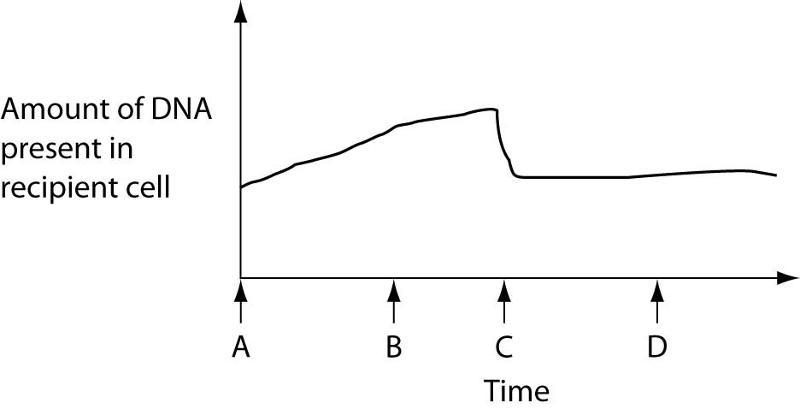
Figure 24.2 depicts changes to the amount of DNA present in a
recipient cell that is engaged in conjugation with an Hfr cell. Hfr
cell DNA begins entering the recipient cell at Time A. Assume that
reciprocal crossing over occurs (in other words, a fragment of the
recipient's chromosome is exchanged for a homologous fragment from the
Hfr cell's DNA). Use Figure 24.2 to answer the following
question.
What is occurring at Time C that is decreasing
the DNA content?
A) crossing over
B) cytokinesis
C) meiosis
D)
degradation of DNA that was not retained in the recipient's
chromosome
E) reversal of the direction of conjugation
D